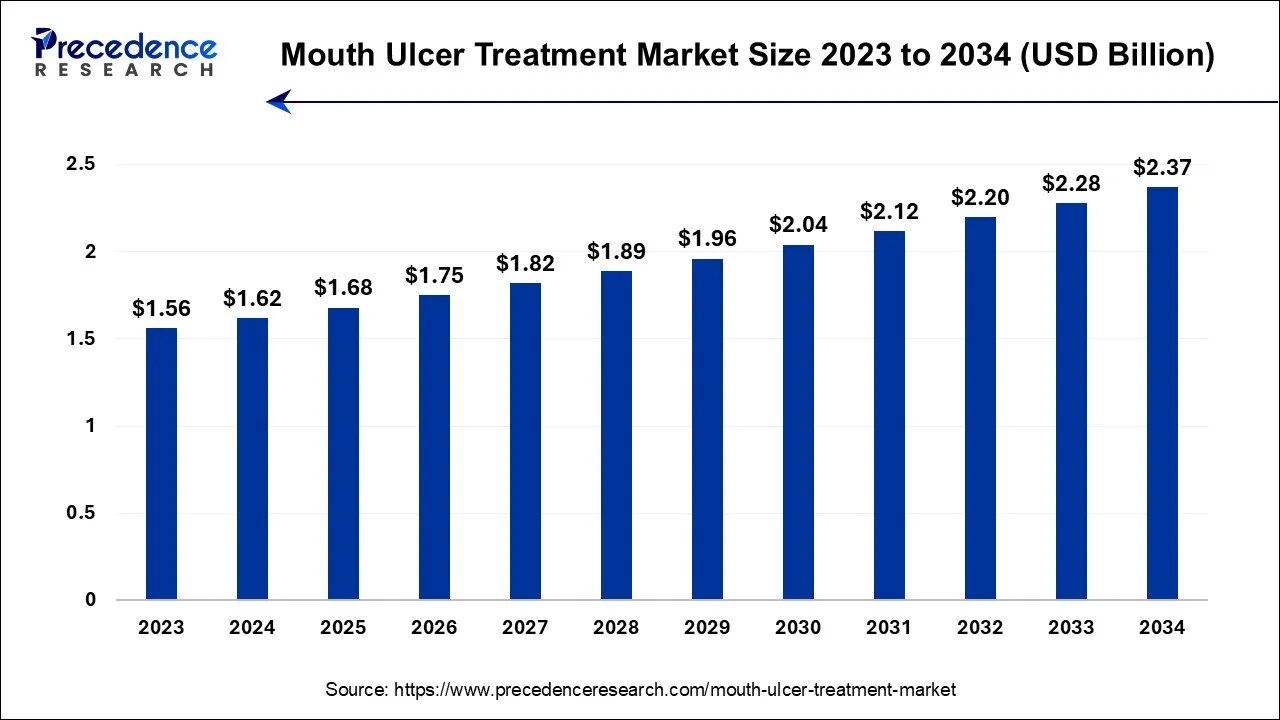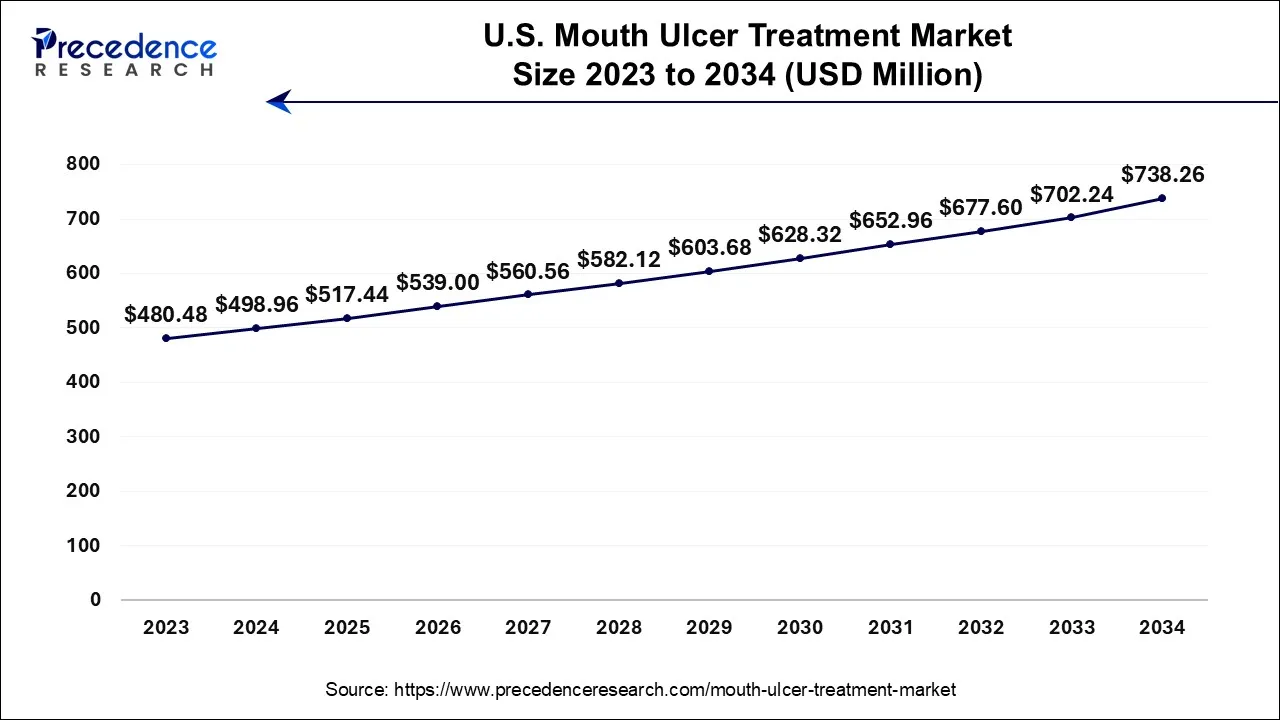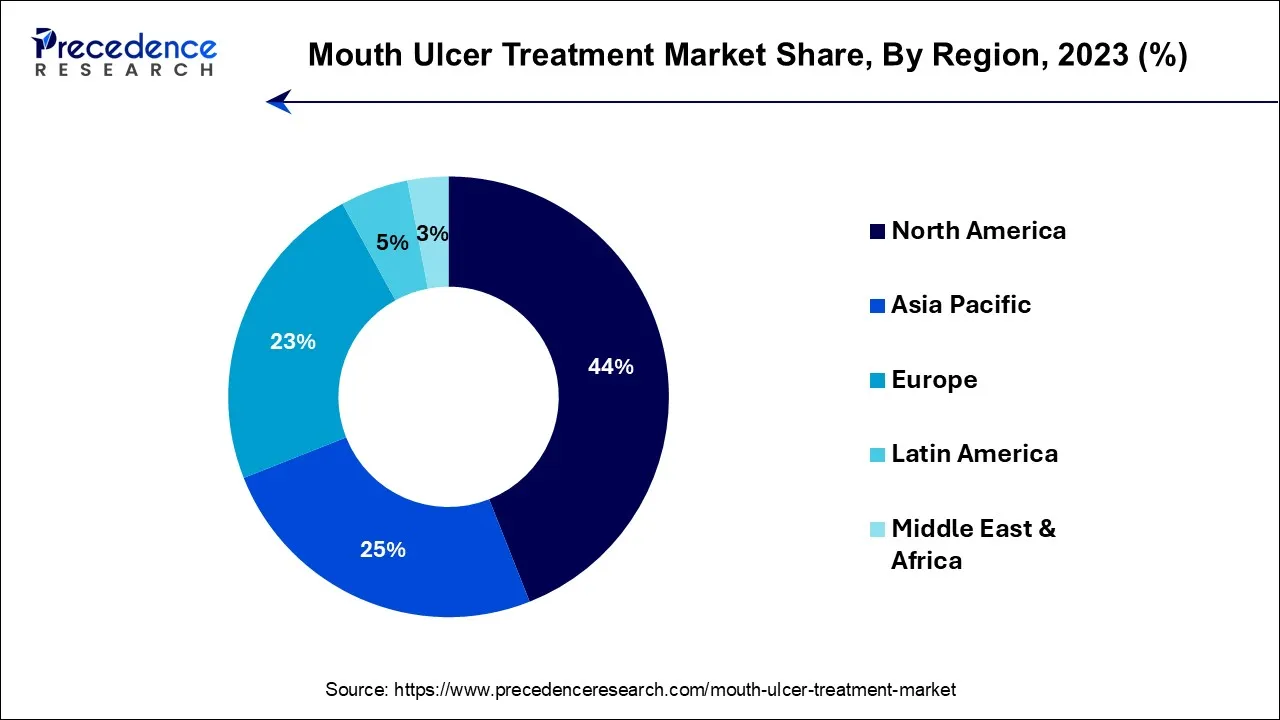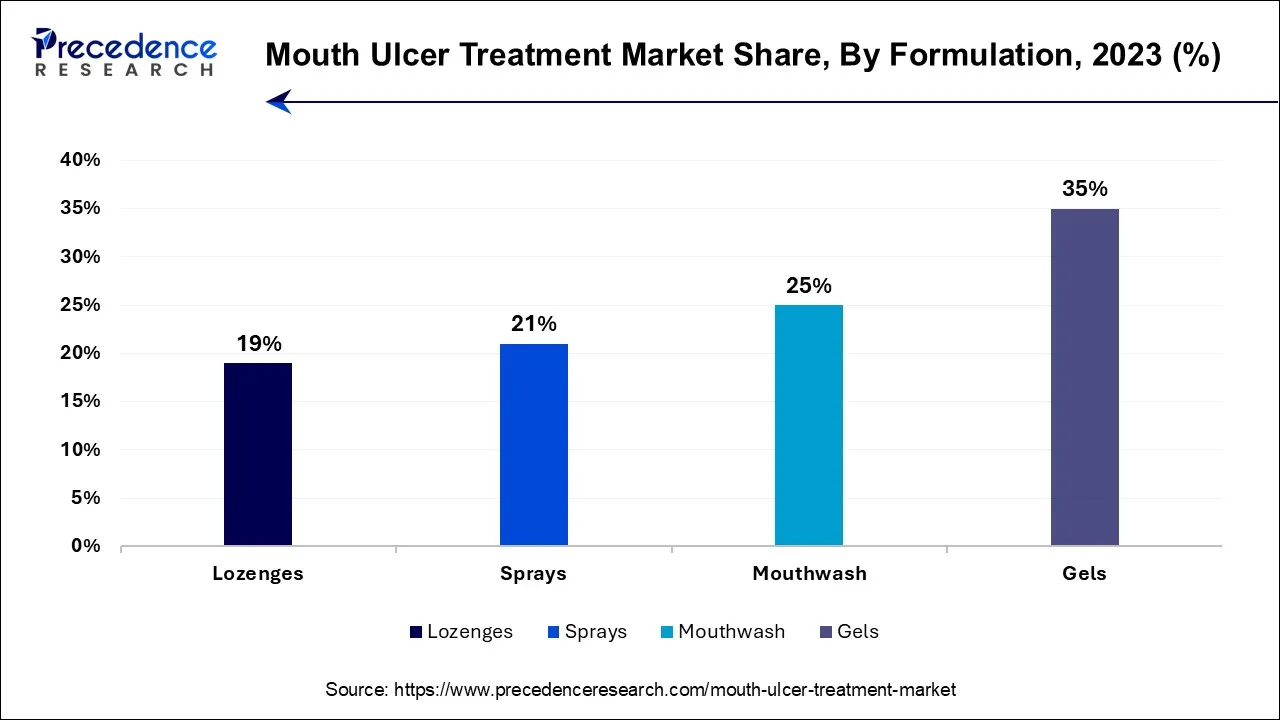August 2024
The global mouth ulcer treatment market size is calculated at USD 1.62 billion in 2024, grew to USD 1.68 billion in 2025, and is predicted to hit around USD 2.37 billion by 2034, poised to grow at a CAGR of 3.9% between 2024 and 2034. The North America mouth ulcer treatment market size accounted for USD 710 million in 2024 and is anticipated to grow at the fastest CAGR of 3.99% during the forecast year.
The global mouth ulcer treatment market size is expected to be valued at USD 1.62 billion in 2024 and is anticipated to reach around USD 2.37 billion by 2034, expanding at a CAGR of 3.9% over the forecast period from 2024 to 2034.

The U.S. mouth ulcer treatment market size is accounted for USD 498.96 million in 2024 and is projected to be worth around USD 738.26 million by 2034, poised to grow at a CAGR of 4% from 2024 to 2034.

North America has held the largest revenue share 44% in 2023. North America commands a significant share in the mouth ulcer treatment market due to several key factors. The region benefits from a robust healthcare infrastructure, high healthcare spending, and a large population with easy access to medical services. Additionally, a growing aging population, which is more prone to oral health issues, fuels demand.
Furthermore, a strong emphasis on oral hygiene and the availability of advanced treatment options contribute to the market's growth. North America's well-established pharmaceutical industry and proactive approach to product development and marketing also play pivotal roles in its dominant position in the mouth ulcer treatment market.

Asia-Pacific is estimated to observe the fastest expansion with the highest CAGR of 4.1% during the forecast period. The Asia-Pacific region holds significant growth in the mouth ulcer treatment market due to several key factors. Firstly, the region has a large and diverse population, including a substantial number of individuals prone to oral health issues, contributing to high demand. Secondly, increasing awareness of oral hygiene and rising disposable incomes have driven the adoption of mouth ulcer treatments.
Additionally, the market benefits from robust pharmaceutical manufacturing capabilities in countries like India and China. Lastly, the presence of a rapidly expanding middle-class population has created a growing consumer base for mouth ulcer treatment products, solidifying Asia-Pacific's major growth in the market.
The sector focused on treating mouth ulcers represents a niche within the pharmaceutical and healthcare industry, exclusively dedicated to managing the distressing lesions that manifest on the mucosal surfaces of the mouth. This domain encompasses a diverse array of therapeutic products, ranging from topical salves and balms to oral solutions engineered to mitigate discomfort, mitigate inflammatory responses, and expedite the regenerative process.
Furthermore, it encompasses a spectrum of treatment options, including over-the-counter remedies and prescription medications tailored for severe cases. The market's expansion is primarily propelled by escalating occurrences of oral ulcers stemming from factors such as heightened stress levels, dietary patterns, and autoimmune disorders, while also being driven by continuous innovation and the quest for novel treatment methodologies.
Within the vast landscape of the pharmaceutical and healthcare sector lies the dynamic domain of mouth ulcer treatment, primarily dedicated to mitigating the anguish and distress associated with oral ulcers. These painful lesions, emerging on the mucosal surfaces of the mouth, stem from various factors, including heightened stress levels, dietary patterns, and autoimmune complexities. Consequently, the mouth ulcer treatment market has experienced substantial expansion, fueled by an upsurge in both incidence rates and pioneering advancements in the field.
One notable trend within the mouth ulcer treatment realm is the burgeoning preference for holistic and herbal remedies, reflecting a consumer quest for milder and more comprehensive approaches to managing oral ulcers. Furthermore, strides in drug delivery mechanisms have ushered in more potent and precisely targeted therapies, augmenting patient outcomes. The heightened awareness surrounding oral health, coupled with readily accessible over-the-counter options, has also bolstered the market's upward trajectory.
The mounting prevalence of oral ulcers attributable to stress, dietary indiscretions, and autoimmune disorders constitutes a prominent driver for market expansion. The aging demographic, susceptible to oral health maladies, further propels this growth. Additionally, pharmaceutical enterprises' unwavering commitment to pioneering novel and more efficacious treatments has been a pivotal factor in driving market dynamics.
Despite the promising prospects, the mouth ulcer treatment sphere grapples with its fair share of challenges. The regulatory labyrinth and protracted approval procedures for innovative treatments can deter progress and market entry. Competition from alternative therapies and home-based remedies presents a formidable challenge to established pharmaceutical solutions. Moreover, pricing pressures and reimbursement complexities within healthcare systems may impact profitability.
Amid this dynamic milieu, enterprises have ample opportunities to tap into, provided they can craft innovative and cost-efficient solutions for addressing oral ulcers. Venturing into burgeoning markets characterized by heightened oral health awareness and increasing disposable incomes unveils untapped business vistas. Collaborative ventures and partnerships with dental professionals and healthcare entities offer a strategic path to penetrate the market effectively.
To encapsulate, the mouth ulcer treatment market is undergoing substantial growth, underpinned by escalating incidence rates, technological breakthroughs, and shifting consumer preferences. While regulatory obstacles and market rivalry pose challenges, the landscape teems with opportunities, including groundbreaking treatments, market expansion into nascent territories, and strategic alliances, rendering it a captivating and ever-evolving facet of the healthcare sector.
| Report Coverage | Details |
| Market Size in 2024 | USD 1.62 Billion |
| Market Size in 2024 | USD 2.37 Billion |
| Growth Rate from 2024 to 2034 | CAGR of 3.9% |
| Largest Market | North America |
| Base Year | 2023 |
| Forecast Period | 2024 to 2034 |
| Segments Covered | By Drug Class and By Formulation |
| Regions Covered | North America, Europe, Asia-Pacific, Latin America, and Middle East & Africa |
Increasing incidence of oral ulcers
The increasing incidence of oral ulcers is a primary driver of growth in the mouth ulcer treatment market. Several factors contribute to this trend. Firstly, modern lifestyles characterized by heightened stress levels, dietary irregularities, and an increased prevalence of autoimmune disorders have led to a surge in the occurrence of oral ulcers. Additionally, hormonal fluctuations and certain medications can also trigger these painful sores.
This rising incidence has spurred greater awareness and concern among individuals regarding their oral health. Consequently, more people seek medical attention and treatment for their mouth ulcers, propelling the demand for effective remedies. As a result, pharmaceutical companies and healthcare providers are investing in research and development to formulate advanced treatments that offer quicker relief and enhanced healing.
The growing patient population, particularly among the aging demographic, further fuels market expansion, as elderly individuals are more susceptible to oral health issues. Altogether, the increasing prevalence of oral ulcers serves as a significant catalyst for innovation and growth in the mouth ulcer treatment market.
Side effects and allergic reactions
Side effects and allergic reactions represent a significant restraint on the growth of the mouth ulcer treatment market. While these treatments aim to provide relief and healing for oral ulcers, some individuals may experience adverse reactions or discomfort when using certain products. This can result in hesitation or reluctance among potential users, limiting the market's expansion. Negative experiences with side effects or allergies can lead to poor consumer reviews, reduced trust in specific treatments, and ultimately a decline in demand.
Pharmaceutical companies and manufacturers must invest in rigorous testing and clinical trials to minimize these risks, but the potential for adverse events remains a concern. Moreover, regulatory authorities may impose strict safety requirements, necessitating extensive documentation and warnings about potential side effects on product labels.
These precautions can further deter consumers and affect market growth. Addressing side effects and allergies through research, development of gentler formulations, and effective communication of safety profiles is crucial to overcome this significant restraint and foster market expansion.
Natural and herbal remedies
The surge in consumer interest in natural and herbal remedies is creating fertile ground for opportunities within the mouth ulcer treatment market. A mounting number of individuals are now in pursuit of gentler, holistic solutions to manage oral ulcers, leaning toward products that feature reduced synthetic chemical content. This burgeoning trend harmonizes with the broader movement towards embracing natural healthcare alternatives and arises from concerns related to potential adverse effects linked to pharmaceutical treatments.
Within this landscape, mouth ulcer treatment providers stand to gain by crafting and marketing offerings that incorporate natural and herbal components renowned for their soothing and curative qualities. These ingredients encompass the likes of aloe vera, chamomile, licorice, and honey, among others. Such formulations represent a promising avenue for fostering innovation and catering to this evolving consumer preference.
Furthermore, elevating the credibility of these natural remedies through scientific research, rigorous clinical trials, and evidence-based efficacy can augment consumer trust and stimulate widespread adoption. Embracing the burgeoning demand for natural and herbal solutions enables companies to tap into an expanding demographic of health-conscious consumers, diversify their product portfolios, and ultimately extend their influence and market presence within the mouth ulcer treatment arena.
According to the drug class, the analgesics and corticosteroids segment has held 37% revenue share in 2023. The dominance of the analgesics and corticosteroids segment in the mouth ulcer treatment market can be attributed to its efficacy in delivering swift pain relief and inflammation reduction linked to oral ulcers. Analgesics offer rapid alleviation of the discomfort arising from mouth ulcers, while corticosteroids, accessible in topical formats, aid in quelling inflammation and expediting the healing process.
These products enjoy widespread recognition and are often recommended by healthcare practitioners, making them the preferred choice for patients seeking immediate respite from the agony and unease associated with mouth ulcers, thus underpinning their substantial market presence.
The antihistamine segment is anticipated to expand at a significantly CAGR of 4.7% during the projected period. The dominance growth of the antihistamine segment in the mouth ulcer treatment market can be attributed to its remarkable efficacy in addressing the pain and inflammation associated with oral ulcers. Antihistamines, easily accessible as over-the-counter options, excel in alleviating symptoms by curtailing the histamine response responsible for swelling and discomfort.
Their extensive availability, established effectiveness, and relatively economical pricing render them a preferred choice for individuals seeking relief from mouth ulcers. Furthermore, the widespread familiarity of antihistamines, often associated with allergy management, has propelled their prominence in the mouth ulcer treatment landscape.
In 2023, the gels segment had the highest market share of 35% on the basis of the Product. The gels segment's commanding position in the mouth ulcer treatment market can be attributed to its remarkable efficacy and user-friendly attributes. These gels excel by establishing a shielding barrier over oral ulcers, promptly alleviating discomfort, and inflammation, and fostering swift recovery. This localized therapeutic precision is a magnet for consumers in quest of immediate solace.
Furthermore, these gels often incorporate potent active compounds, such as analgesics and antiseptics, further elevating their remedial potency. Their non-invasive application and simplicity make them a preferred choice, whether for over-the-counter or prescribed regimens, thus unequivocally substantiating their preeminent status within the market.

The sprays segment is anticipated to expand at the fastest rate over the projected period. The sprays segment holds substantial growth in the mouth ulcer treatment market due to several factors. Firstly, sprays offer a convenient and targeted application method, allowing users to directly apply medication to the affected area, ensuring quick relief. Secondly, they often contain active ingredients that provide both pain relief and promote healing, making them popular among consumers. Additionally, the ease of use, portability, and reduced risk of contamination compared to gels or ointments make sprays a preferred choice. These attributes have propelled the sprays segment to a major growth of the mouth ulcer treatment market.
Segments Covered in the Report
By Drug Class
By Formulation
By Geography
For inquiries regarding discounts, bulk purchases, or customization requests, please contact us at sales@precedenceresearch.com
No cookie-cutter, only authentic analysis – take the 1st step to become a Precedence Research client
August 2024
December 2024
September 2024
January 2025